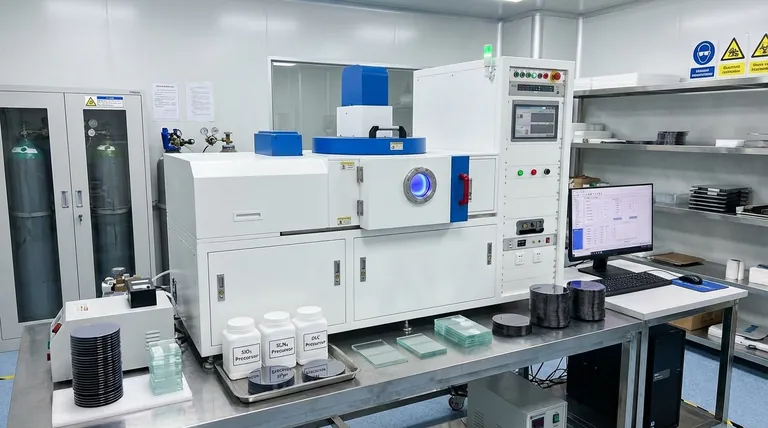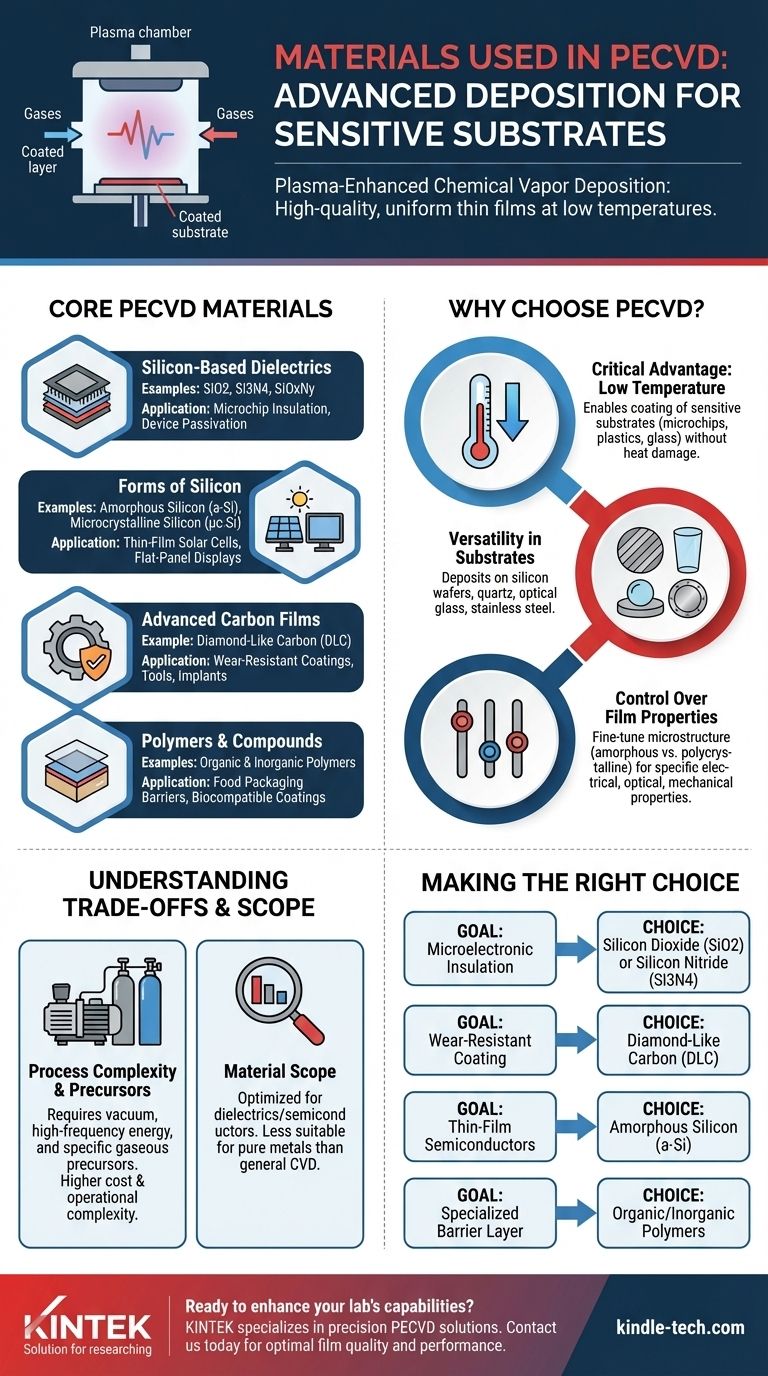The most common materials deposited using PECVD are silicon-based dielectrics and semiconductors. These include silicon dioxide (SiO2), silicon nitride (Si3N4), silicon oxynitride (SiOxNy), and amorphous or microcrystalline silicon. The technique is also widely used for creating advanced coatings like diamond-like carbon (DLC) for specialized applications.
Plasma-Enhanced Chemical Vapor Deposition (PECVD) is not defined by a single material, but by its core capability: depositing high-quality, uniform thin films at significantly lower temperatures than traditional methods. This makes it the go-to process for coating sensitive substrates used in modern electronics and advanced manufacturing.

The Core Materials of PECVD
PECVD is a versatile process capable of depositing a range of materials. However, its primary industrial and research applications are concentrated around a few key categories.
Silicon-Based Dielectrics
The most frequent use of PECVD is for depositing insulating (dielectric) films. These materials are fundamental to building modern microchips.
The primary materials are silicon dioxide (SiO2), silicon nitride (Si3N4), and silicon oxynitride (SiOxNy). They serve as insulating layers between conductive components and for device encapsulation, protecting the sensitive electronics from the environment.
Forms of Silicon
PECVD is also a crucial method for depositing silicon itself, but in specific non-crystalline forms.
This includes amorphous silicon (a-Si) and microcrystalline silicon (μc-Si). These films are essential semiconductor layers in applications like thin-film solar cells and flat-panel displays.
Advanced Carbon Films
Beyond silicon, PECVD excels at creating highly durable carbon-based coatings.
Diamond-Like Carbon (DLC) is a key material deposited via PECVD. Its extreme hardness and low friction make it ideal for tribological applications, such as protective coatings on machine tools, automotive parts, and medical implants to reduce wear.
Polymers and Other Compounds
The flexibility of the plasma process extends to more complex molecules.
PECVD can be used to deposit thin films of organic and inorganic polymers. These specialized films are used in advanced food packaging to create barrier layers and in biomedical devices for biocompatible coatings.
Why PECVD Is Chosen for These Materials
The choice to use PECVD is driven by the process's unique advantages, which are particularly suited for delicate and high-precision manufacturing.
The Critical Advantage of Low Temperature
Unlike traditional Chemical Vapor Deposition (CVD) which relies on high heat, PECVD uses an energized plasma to drive the chemical reactions.
This use of an external energy source allows deposition to occur at much lower temperatures. This is essential for coating substrates that cannot withstand high heat, such as fully fabricated microchips, plastics, or certain types of glass.
Versatility in Substrates
The lower processing temperature expands the range of materials that can be coated.
PECVD can successfully deposit films on a wide variety of substrates, including silicon wafers, quartz, optical glass, and even stainless steel, without damaging them.
Control Over Film Properties
The plasma process gives engineers and scientists a high degree of control over the final film.
By adjusting parameters like gas composition, pressure, and power, it's possible to fine-tune the material's microstructure—for example, creating amorphous versus polycrystalline films—to achieve specific electrical, optical, or mechanical properties.
Understanding the Trade-offs
While powerful, PECVD is not a universal solution. It involves specific requirements and limitations that must be considered for any application.
Process Complexity
A PECVD system is more complex than some other deposition methods.
It requires a vacuum reaction chamber, a pressure reduction system to maintain the plasma, and a high-frequency energy source (like radio frequency or microwave) to ionize the gases. This increases the equipment's cost and operational complexity.
Dependence on Precursor Gases
The process is fundamentally limited by the availability of suitable precursor gases.
The material to be deposited must be available in a gaseous chemical form that can be safely handled and effectively broken down by the plasma to react and form the desired film.
Material Scope
While versatile, PECVD is most optimized for the materials discussed above.
General CVD can deposit a wider range of materials, including pure metals like tungsten and titanium. PECVD is a specialized subset, excelling where low temperatures and high-quality dielectric or semiconductor films are the priority.
Making the Right Choice for Your Application
Selecting the right material is entirely dependent on your end goal. The versatility of PECVD allows it to serve many different technological needs.
- If your primary focus is microelectronic insulation or passivation: Your choice will be silicon dioxide (SiO2) or silicon nitride (Si3N4) for their excellent dielectric properties.
- If your primary focus is a wear-resistant coating: Diamond-Like Carbon (DLC) is the ideal material due to its extreme hardness and low coefficient of friction.
- If your primary focus is creating thin-film semiconductors: Amorphous silicon (a-Si) is the standard choice for applications like solar cells and displays.
- If your primary focus is creating a specialized barrier layer: Organic or inorganic polymers deposited via PECVD are used for advanced packaging and biomedical surfaces.
Ultimately, PECVD empowers the creation of advanced devices by enabling the deposition of critical, high-performance films onto substrates that couldn't survive harsher methods.
Summary Table:
| Material Category | Key Examples | Primary Applications |
|---|---|---|
| Silicon-Based Dielectrics | SiO2, Si3N4, SiOxNy | Microchip insulation, device passivation |
| Forms of Silicon | Amorphous Silicon (a-Si), Microcrystalline Silicon (μc-Si) | Thin-film solar cells, flat-panel displays |
| Advanced Carbon Films | Diamond-Like Carbon (DLC) | Wear-resistant coatings for tools, automotive parts, medical implants |
| Polymers | Organic/Inorganic Polymers | Barrier layers for food packaging, biocompatible coatings |
Ready to enhance your lab's capabilities with precision PECVD solutions? KINTEK specializes in providing high-quality lab equipment and consumables tailored to your deposition needs. Whether you're working with sensitive electronics, advanced coatings, or specialized substrates, our expertise ensures you achieve optimal film quality and performance. Contact us today to discuss how our PECVD solutions can drive your research and manufacturing forward!
Visual Guide

Related Products
- RF PECVD System Radio Frequency Plasma-Enhanced Chemical Vapor Deposition RF PECVD
- Customer Made Versatile CVD Tube Furnace Chemical Vapor Deposition Chamber System Equipment
- Split Chamber CVD Tube Furnace with Vacuum Station Chemical Vapor Deposition System Equipment Machine
- 1200℃ Split Tube Furnace with Quartz Tube Laboratory Tubular Furnace
- Aluminum Foil Current Collector for Lithium Battery
People Also Ask
- What is an example of PECVD? RF-PECVD for High-Quality Thin Film Deposition
- What is the principle of plasma enhanced chemical vapor deposition? Achieve Low-Temperature Thin Film Deposition
- What is plasma activated chemical vapour deposition method? A Low-Temperature Solution for Advanced Coatings
- What are the benefits of PECVD? Achieve Superior Low-Temperature Thin Film Deposition
- Why does PECVD commonly use RF power input? For Precise Low-Temperature Thin Film Deposition



















